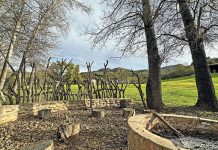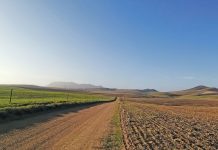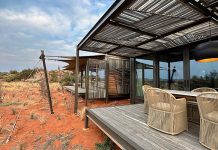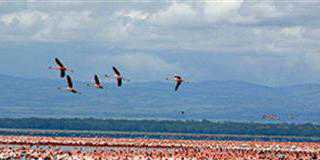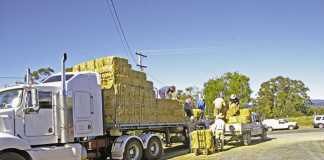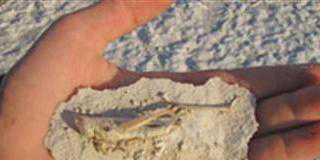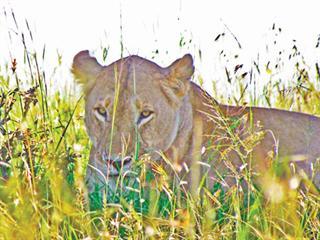
Clouds of dust billowed across the road. We could hardly see where we were going. The thundering hooves of galloping buffalo, impala and zebra beside our vehicle convinced us that we were about to see a lion kill. Bouncing through potholes, trying to keep up, we strained our eyes to see ahead, when suddenly a man, running full tilt in front of us, loomed out of the haze.
In my shock, I forgot I had my camera ready as we were game viewing in Lake Nakuru National Park in Kenya, known for its abundant population of lions, cheetah and leopard. The man was a perfect target for any pursuing predator. As we drew closer, we saw he was running after another vehicle disappearing in the distance.
Sensing us behind him, he turned around and ran frantically towards us. As he came alongside, covered in dust, we saw only the whites of his eyes as he begged us for a lift. He turned out to be a Kenya Wildlife Service (KWS) ranger, who was on the back of the other vehicle and dropped his cellphone overboard when they stopped for a moment. He jumped off to retrieve it, but his colleagues, unaware of this, drove off and left him behind.
No sooner had we picked him up when a green KWS Toyota Land Cruiser appeared over the horizon with two worried-looking officials in the cab, who had come for their missing colleague. The embarrassed ranger clambered onto the back while the driver read him the riot act in Swahili, as if he wasn’t scared enough.
The extreme gravity of his situation only really dawned on us the next morning when, near the place where we’d met our ‘hitchhiker’ the previous afternoon, we came upon a large pride of lions. The alpha female lay panting in the shade of a thorn thicket. Her pride of 12 lionesses rested nearby, lying on their backs with paws in the air and tongues lolling. They had brought down a buffalo during the night.
The alpha male and two young lions had gorged themselves first; the females had eaten next and now the cubs were squabbling over the large, partially eaten beast. Vultures hung around nearby, occasionally trying to steal a scrap but the cubs chased them off.
When the African sun began to lose its heat, they would move in and have a feast. The hyenas would slink in after dark to tidy up, even crunching the bones.
When prey turns on predator
Not all hunts are as successful as this one. The old lioness had seen many of her pride die; recently one was kicked to death by a giraffe. The quarry had turned on the young lioness crouching behind her and with one blow, crushed her spine.
Three summers ago, during a very dry season, prey was scarce in the area and the pride was suffering. Although the adults were constantly hungry, the cubs were literally starving to death. Often there’s not much left of a kill for the youngsters and they waste away. And weaned cubs aren’t able to hunt until they’re a year old.
One moonless night, the lioness crept up on a herd of buffalo. The other lionesses instinctively spread out while she homed in on a calf standing apart from the others. Her tawny-coloured fur blending with the colour of the grass, she slunk to within 30m of her target, propelled herself forward in a short burst and launched herself onto the animal.
Closing her powerful jaws over its nose and digging her front claws into its neck, she tried to suffocate the hapless victim so other lionesses could bring it down and kill it. However, before they could get near, the rest of the herd closed around the calf, the closest butting the lioness. When the glancing blow of a horn hit her, she had to let go. She slunk away between their legs, her stomach heaving with each breath.
The alpha lioness was born in the park 14 summers ago and she was now beginning to feel the strain of the hunt. She was losing her teeth and while feeding on the carcass earlier, she was unable to satisfy her hunger. Soon her eyesight would dim and she’d become less agile, making it impossible for her to hunt successfully. Her position in the pride would be usurped by the strongest female and her days would be over.
Lion symbolism
As in much of the world, in Africa the image of the lion signifies power and majesty. Lion symbols in many cultures are indicative of fearlessness, courage and power. The ‘king of the jungle’ is mentioned in fables, mythology and ancient religions. In the Bible lions were depicted on Solomon’s throne.
Apedemak, the Lion God, who symbolised the regality, strength and courage of the African lion, was one of the most important gods of Kush, an 8th century Nubian state formed after the disintegration of the Kingdom of Egypt, when the Kushites ruled as pharaohs for a century.
Apedemak was also the iconic symbol and royal insignia of the Royal House of Kush, which established lion sanctuaries and kept pet lions. Today the capital Meroë lies in ruins in present-day North Sudan. There are reliefs on the walls of the ruins depicting a lion being led on a rope at the lion temple of Naqa, north of Khartoum, while the image of Apedemak remains pervasive among the ruins of Meroë.
The Kushite kings were the original ‘Lion Kings’. Pet lions were also popular in other African royal households. Haile Selassie I, the emperor of Ethiopia, also known as the Lion of Judah, had several lions wandering around the gardens of his compound.
‘Tame’ lions
Today ‘lion hugging’ and over-familiarity with big cats has become increasingly commonplace at so-called ‘lion parks’. For a fee of about R250, in addition to tea and scones, you can cuddle and bottlefeed a lion cub. However, these are wild predators, inhabiting wild places, and this is what they should remain.
This habituation to humans only creates big cats with no fear of us. It leads to abnormal behaviour which ensures a life sentence for these wild creatures behind bars. This does nothing for their conservation. They should be conserved in the wild – we owe it to the kings and queens of the jungle – Edited by Abré J Steyn.
Contact Abré J Steyn on 083 235 4822 or at [email protected], with ‘Field Sports’.” in the subject line.


